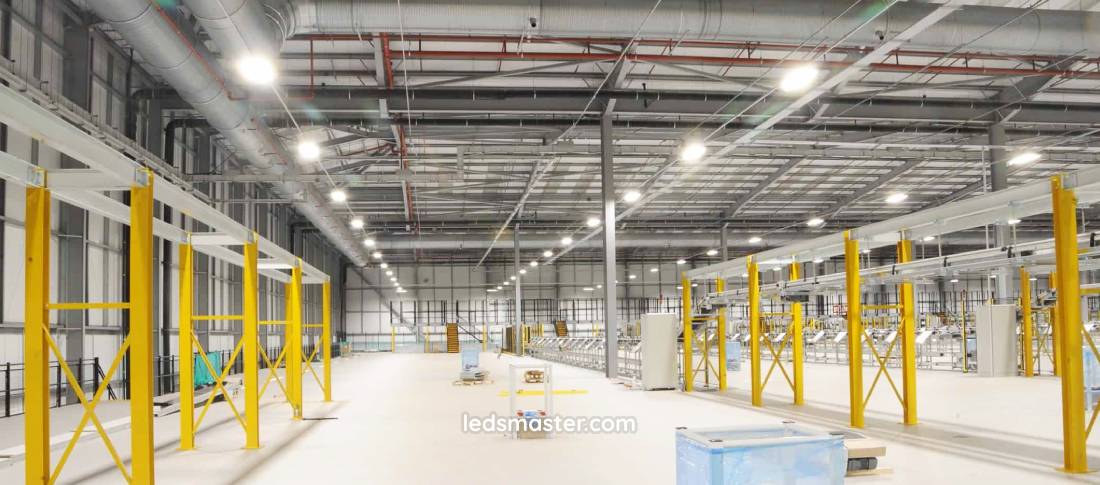
Transform your space with precision lighting! Mastering key parameters like lux, CRI, and uniformity will elevate your environment with vibrant, energy-efficient LED solutions. Discover how to make your surroundings shine with brilliance and clarity!
Get your complimentary lighting design today
These parameters, including lux, Color Rendering Index (CRI), and uniformity, play a critical role in determining the effectiveness and quality of illumination in various environments. This article explores these fundamental lighting parameters and their significance in the context of LED lighting.
Table of Contents
ToggleLux is a unit of measurement that quantifies the intensity of light that falls on a surface. Determining how well a space is illuminated and for ensuring that lighting meets the needs of its occupants. The appropriate lux level depends on the function of the space. For example, general residential areas typically require between 100 and 300 lux, which provides adequate illumination for everyday activities. In contrast, workspaces such as offices, laboratories, or classrooms often need higher lux levels, ranging from 500 to 1000 lux, to ensure clear visibility and reduce eye strain.
LED lighting excels in delivering precise lux levels. LEDs are highly efficient and can produce the desired light intensity while consuming less power compared to traditional incandescent or fluorescent bulbs. This efficiency allows for achieving optimal lux levels in various applications without excessive energy consumption. Additionally, LEDs offer the flexibility to adjust light output, making them suitable for spaces that require variable lighting conditions.

The Color Rendering Index (CRI) is a metric used to assess the quality of light produced by different light sources, particularly in relation to how accurately they reveal the true colors of objects. The measurement is framed against the natural light spectrum, particularly that of daylight, which serves as a benchmark for color accuracy. The CRI scale ranges from 0 to 100, with higher values indicating a better ability to render colors faithfully. A light source with a CRI of 100 means that colors are rendered with perfect accuracy, just as they would be under natural sunlight. This index plays an important role in various applications, influencing choices in lighting design across different environments.
For most indoor settings, such as homes and offices, a CRI of 80 or above is typically regarded as acceptable. However, certain contexts require more stringent color accuracy standards. For example, in art galleries, where the accurate portrayal of color is essential for both artists and viewers, a CRI of 90 or higher is often preferred. Similarly, retail environments that rely on the true representation of product colors to influence consumer decisions also benefit from higher CRI values. In medical facilities, the accuracy of color rendering can directly impact diagnosis and treatment, making high CRI values essential for effective lighting in these contexts.
One of the advancements in lighting technology has been the development of LED (Light Emitting Diode) lighting. Compared to older lighting technologies such as incandescent and fluorescent bulbs, LEDs have substantially improved CRI performance. High-quality LEDs can achieve CRI values of 90 to 95, or even higher in some specialized applications. This improvement ensures that colors appear true to life, enhancing the experience in environments where color differentiation is paramount.
The rise of LED lighting has transformed the landscape of various industries by providing not only better color rendering but also enhanced energy efficiency. In art galleries, the natural vibrancy of artworks can be amplified under LED lighting, attracting viewers and enhancing their overall experience. Similarly, in retail settings, products displayed under high-CRI LED lighting appear more appealing, which can lead to increased sales. In medical environments, accurate color rendering under LEDs can help healthcare professionals identify conditions more effectively, underscoring the critical nature of proper lighting in such settings.
Uniformity refers to the even distribution of light across a given area. Achieving uniformity in lighting is significant for creating spaces that are comfortable and functional. Properly distributed light minimizes the occurrence of shadows and hot spots, which can lead to visual discomfort and impede performance on tasks. In workplace settings, uniform lighting is beneficial in reducing eye strain and enhancing productivity by providing consistent illumination across work surfaces.
LED lighting is particularly well-suited for achieving uniformity due to its inherent design flexibility. The layout and arrangement of LED fixtures can be customized to ensure even light distribution, addressing issues related to uneven illumination that can occur with traditional lighting solutions. Moreover, advanced optics and diffuser technologies utilized in LED fixtures greatly enhance uniformity by promoting a more even spread of light and diminishing harsh shadows.
The ability of LEDs to create uniform light distributions is especially advantageous in various applications. In office environments, for instance, evenly distributed lighting contributes to a more comfortable working atmosphere, reducing fatigue and enhancing focus. In retail settings, uniform lighting ensures that products are evenly illuminated, which can improve visibility and attractiveness. In educational settings, uniform lighting supports better learning conditions, allowing students to focus without the distraction of varying light levels.
Among the many benefits of LED lighting, energy efficiency stands out as one of the noteworthy. LEDs consume considerably less power compared to traditional incandescent or fluorescent lighting while providing the same or even higher levels of illumination. This energy efficiency translates into lower electricity bills, making LEDs a cost-effective choice for both residential and commercial applications.
By choosing LED lighting, users can achieve their desired lighting levels without incurring unnecessary energy expenses. Additionally, the reduced power consumption contributes to a lower overall environmental footprint, aligning with the growing emphasis on sustainability in both personal and corporate settings. The shift toward LED technology represents a practical step toward energy conservation, highlighting the importance of responsible energy use in contemporary society.
Another compelling advantage of LED lighting is its longevity. LEDs are known for their impressive lifespan, often exceeding 25,000 hours of operation. This extended operational life reduces the frequency of bulb replacements, which is particularly beneficial in hard-to-reach areas or environments with high usage rates. For instance, in commercial applications, minimizing the need for frequent replacements can significantly reduce labor costs and downtime associated with changing lights.
Moreover, the lower maintenance costs associated with LEDs further contribute to their appeal as a lighting solution. Unlike traditional lighting options that may require regular replacements and maintenance, LEDs are less prone to failure. This reliability ensures that users spend less time and money managing their lighting systems, allowing them to focus on their core activities instead of routine maintenance tasks.
Color temperature is another factor to consider in lighting design, measured in Kelvins (K). It indicates the hue of light emitted by a fixture and ranges from warm white (below 3000K) to cool white (above 4000K). The choice of color temperature has a significant impact on the ambiance and functionality of a space.
Warm white light creates a cozy and inviting atmosphere, making it suitable for residential settings such as living rooms and bedrooms. On the other hand, cooler white light enhances focus and clarity, making it ideal for workspaces and retail environments. For example, cooler light temperatures can help employees remain alert and productive, while warmer tones may be better suited for relaxation and comfort.
Understanding the implications of color temperature allows designers to tailor lighting solutions to meet the specific needs of different environments. This flexibility in lighting design is one of the reasons why LED technology has become increasingly popular; it enables users to create spaces that align with both aesthetic preferences and functional requirements.
The environmental impact of LED lighting is considerably less than that of traditional lighting technologies. LEDs do not contain hazardous materials like mercury, which is often present in fluorescent bulbs. This absence of harmful substances makes LEDs safer for handling and disposal, contributing to a more environmentally friendly approach to lighting.
Furthermore, the energy efficiency of LEDs reduce overall carbon emissions. By choosing LEDs, individuals and organizations can significantly lower their energy consumption, aligning their lighting choices with broader environmental sustainability goals. This focus on eco-friendly lighting solutions resonates with a growing societal awareness of the need for environmentally responsible practices across various sectors.
LEDs are designed to operate efficiently across a wide range of temperatures, making them suitable for diverse environments, including those with fluctuating temperatures. Many LED fixtures also offer dimming capabilities, allowing users to adjust light levels according to their specific needs. This feature not only enhances energy savings but also provides greater control over the lighting ambiance, contributing to a more flexible and adaptable lighting solution.
The ability to dim lighting can create different moods and settings, making LEDs versatile for multiple applications. For instance, in residential settings, dimmable LEDs can facilitate transitions from bright, functional lighting during the day to softer, ambient lighting in the evening. In commercial environments, dimming can help create a more welcoming atmosphere for customers during off-peak hours while maintaining high visibility during busier times.
When transitioning from traditional lighting to LEDs, compatibility with existing fixtures and controls is an consideration. Some LED retrofits may require specific types of dimmers or adapters to function properly, which can lead to installation challenges if not addressed. Ensuring compatibility with current systems is vital for preventing potential issues during the installation process.
To facilitate a smooth transition to LED technology, it is advisable to consult lighting professionals or review manufacturer specifications. Such proactive measures can help users maximize the benefits of LED lighting while minimizing potential disruptions to their existing systems. Whether upgrading an entire facility or replacing individual fixtures, careful planning and consideration of compatibility are key factors in successfully adopting LED lighting.

The ongoing quest for better lighting solutions will encourage collaboration among researchers, designers, and manufacturers. This collaborative spirit will foster breakthroughs that enhance lighting quality, energy efficiency, and user experience. As a result, the future of lighting will likely be characterized by a blend of artistry and technology, resulting in visually stunning and highly functional illumination options.
In various settings—be it homes, offices, or public spaces—the transition to LED lighting represents a commitment to more responsible energy use and environmental stewardship. As awareness of these benefits grows, the momentum toward widespread adoption of LED technology will continue to shape the landscape of modern lighting solutions.
With the capacity to offer superior color rendering, energy efficiency, and design flexibility, LED lighting emerges as a transformative force in the realm of illumination. This evolution in lighting technology promises not only practical advantages but also an opportunity to create beautiful, functional spaces that align with the values of contemporary society.
Understanding lighting parameters such as lux, CRI, and uniformity is essential for selecting and replacing lighting solutions effectively. LEDs offer numerous advantages, including improved energy efficiency, longer lifespan, and enhanced color rendering, making them a superior choice for a wide range of applications. By considering these parameters and leveraging the benefits of LED technology, individuals and organizations can achieve optimal lighting performance, enhance visual comfort, and contribute to environmental sustainability. Whether upgrading a residential space, office, or industrial setting, LEDs provide a versatile and effective lighting solution tailored to various needs and preferences.